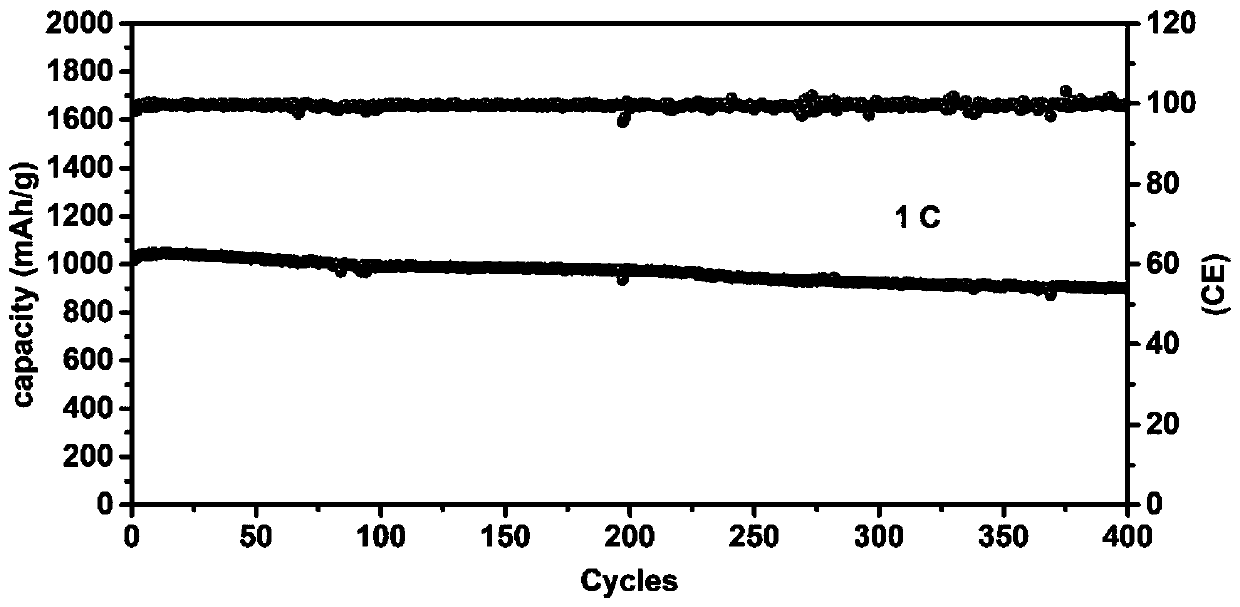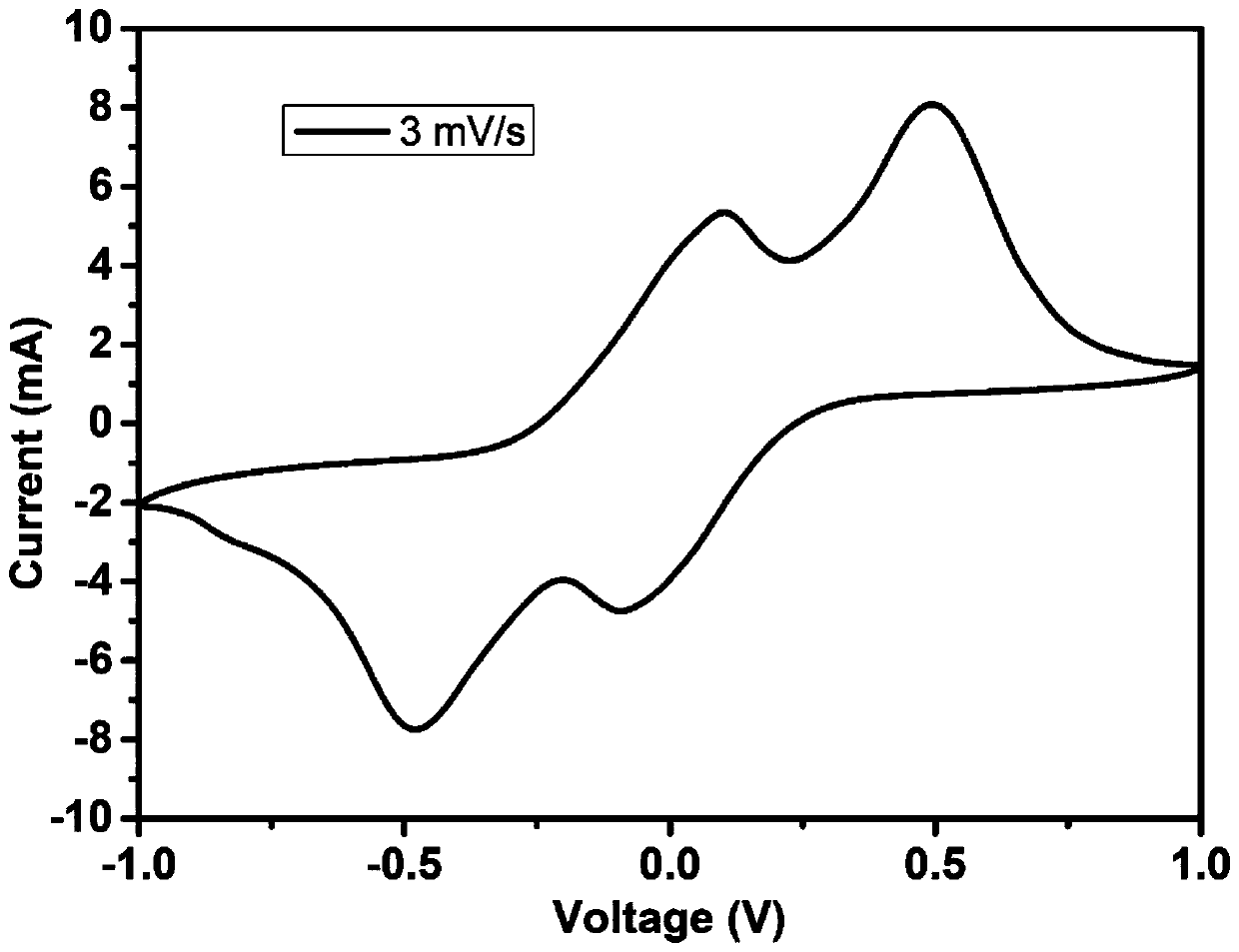Preparation method of network-like carbon-loaded iron-based compound material and application of network-like carbon-loaded iron-based compound material in lithium-sulfur battery
A lithium-sulfur battery and network-like technology, applied in the field of electrochemistry, can solve the problems of inhibition of the shuttling effect of difficult polysulfide compounds, lack of in-depth research on catalysis, and reduce the use of noble metal catalysts, so as to inhibit the shuttling effect and increase the effect of sulfur fixation , The synthetic method is simple and convenient
- Summary
- Abstract
- Description
- Claims
- Application Information
AI Technical Summary
Problems solved by technology
Method used
Image
Examples
Embodiment example 1
[0030] At room temperature, 1.0050 g of ferric nitrate nonahydrate and 10 mL of GO (5 mg / mL) were added to 40 mL of deionized water, sonicated for 2 hours and stirred for 12 hours. 1.0052 g of glucose was added and stirring was continued for 8 hours at room temperature. The resulting homogeneous mixture was transferred into a hydrothermal kettle and kept at 180°C for 10 hours. After the reaction kettle was lowered to room temperature, it was suction-filtered, washed three times with deionized water, and dried at 60°C. The dried product was thoroughly ground and mixed with 10 times the mass of melamine, and then kept at 900°C for 1 hour under the protection of argon with a heating rate of 5°C / min. When the temperature drops to room temperature, mix the resulting material and binder (PVDF) at a ratio of 9:1, add NMP and stir at room temperature for 12 hours to form a uniform slurry, which is coated on a commercial PP separator with a thickness of 10 microns and heated at 80°C D...
Embodiment example 2
[0036] At room temperature, 1.5 g of ferric nitrate nonahydrate and 20 mL of GO (5 mg / mL) were added to 40 mL of deionized water, sonicated for 1 hour and stirred for 8 hours. 2 g of glucose were added and stirring was continued for 12 hours at room temperature. The resulting homogeneous mixture was transferred into a hydrothermal kettle and kept at 160°C for 10 hours. After the reaction kettle was lowered to room temperature, it was suction-filtered, washed three times with deionized water, and dried at 60°C. The dried product was thoroughly ground and mixed with 8 times the mass of melamine, and then kept at 800°C for 4 hours under the protection of argon with a heating rate of 5°C / min. When the temperature drops to room temperature, mix the resulting material and binder (PVDF) at a ratio of 9:1, add NMP and stir at room temperature for 12 hours to form a uniform slurry, which is coated on a commercial PP separator with a thickness of 10 microns and heated at 80°C Dry for 1...
Embodiment example 3
[0042] At room temperature, 0.5 g of ferric nitrate nonahydrate and 15 mL of GO (5 mg / mL) were added to 40 mL of deionized water, sonicated for 3 hours and stirred for 10 hours. 0.5 g of glucose was added and stirring was continued for 10 hours at room temperature. The resulting homogeneous mixture was transferred into a hydrothermal kettle and kept at 170°C for 13 hours. After the reaction kettle was lowered to room temperature, it was suction-filtered, washed three times with deionized water, and dried at 60°C. The dried product was thoroughly ground and mixed with 6 times the mass of melamine, and then kept at 1000°C for 2 hours under the protection of argon with a heating rate of 5°C / min. When the temperature drops to room temperature, mix the resulting material and binder (PVDF) at a ratio of 9:1, add NMP and stir at room temperature for 12 hours to form a uniform slurry, which is coated on a commercial PP separator with a thickness of 10 microns and heated at 80°C Dry f...
PUM
 Login to View More
Login to View More Abstract
Description
Claims
Application Information
 Login to View More
Login to View More - R&D
- Intellectual Property
- Life Sciences
- Materials
- Tech Scout
- Unparalleled Data Quality
- Higher Quality Content
- 60% Fewer Hallucinations
Browse by: Latest US Patents, China's latest patents, Technical Efficacy Thesaurus, Application Domain, Technology Topic, Popular Technical Reports.
© 2025 PatSnap. All rights reserved.Legal|Privacy policy|Modern Slavery Act Transparency Statement|Sitemap|About US| Contact US: help@patsnap.com



